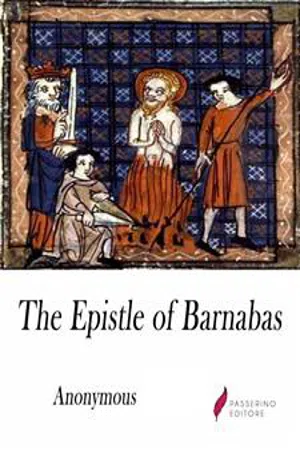
- English
- ePUB (mobile friendly)
- Available on iOS & Android
The Epistle of Barnabas
About this book
The Epistle of Barnabas is a Greek epistle written between 70–132 CE. It is preserved complete in the 4th-century Codex Sinaiticus, where it appears immediately after the New Testament and before the Shepherd of Hermas. For several centuries it was one of the "antilegomena" writings that some Christians looked on as sacred scripture, while others excluded them. Eusebius of Caesarea classified it as such. It is mentioned in a perhaps third-century list in the sixth-century Codex Claromontanus and in the later Stichometry of Nicephorus appended to the ninth-century Chronography of Nikephoros I of Constantinople. Some early Fathers of the Church ascribed it to the Barnabas who is mentioned in the Acts of the Apostles, but it is now generally attributed to an otherwise unknown early Christian teacher, perhaps of the same name. It is distinct from the Gospel of Barnabas. Barnabas born Joseph, was according to tradition an early Christian, one of the prominent Christian disciples in Jerusalem. According to Acts 4:36, Barnabas was a Cypriot Jew. Named an apostle in Acts 14:14, he and Paul the Apostle undertook missionary journeys together and defended Gentile converts against the Judaizers. They traveled together making more converts (c. 45–47), and participated in the Council of Jerusalem (c. 50). Barnabas and Paul successfully evangelized among the "God-fearing" Gentiles who attended synagogues in various Hellenized cities of Anatolia. Translated by Robert Ernest Wallis
Frequently asked questions
- Essential is ideal for learners and professionals who enjoy exploring a wide range of subjects. Access the Essential Library with 800,000+ trusted titles and best-sellers across business, personal growth, and the humanities. Includes unlimited reading time and Standard Read Aloud voice.
- Complete: Perfect for advanced learners and researchers needing full, unrestricted access. Unlock 1.4M+ books across hundreds of subjects, including academic and specialized titles. The Complete Plan also includes advanced features like Premium Read Aloud and Research Assistant.
Please note we cannot support devices running on iOS 13 and Android 7 or earlier. Learn more about using the app.
Information
Table of contents
- Cover
- The Epistle of Barnabas
- Table of contents
- After the salutation, the writer declares that he would communicate to his brethren something of that which he had himself received
- The Jewish sacrifices are now abolished
- The fasts of the Jews are not true fasts, nor acceptable to God
- Antichrist is at hand: let us therefore avoid Jewish errors
- The new covenant, founded on the sufferings of Christ, tends to our salvation, but to the Jews' destruction
- The sufferings of Christ, and the new covenant, were announced by the prophets
- Fasting, and the goat sent away, were types of Christ
- The red heifer a type of Christ
- The spiritual meaning of circumcision
- Spiritual significance of the precepts of Moses respecting different kinds of food
- Baptism and the cross prefigured in the Old Testament
- The cross of Christ frequently announced in the Old Testament
- Christians, and not Jews, the heirs of the covenant
- The Lord has given us the testament which Moses received and broke
- The false and the true Sabbath
- The spiritual temple of God
- Conclusion of the first part of the epistle
- Second part of the epistle. The two ways
- The way of light
- The way of darkness
- Conclusion